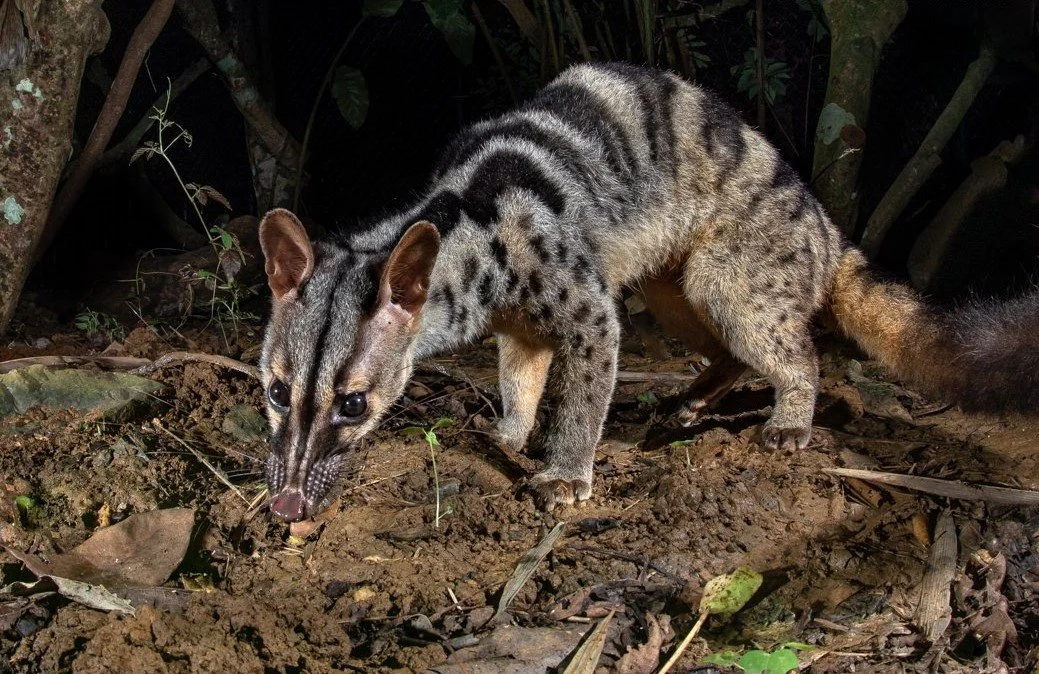Species
A collection of animal species from around the world.
*Sources for information and photos (unless they were taken by me) can be found at the bottom of each species profile.
Owston's Civet
Owston's civet is a cryptic creature from the Annamite Mountains, straddling the border of Vietnam and Laos. With its skinny snout, it sniffs and searches through leaf litter for its favourite food: earthworms.
Iriomote Cat
The Iriomote cat occupies the smallest habitat of any wild cat on Earth — found only on Japan's southern Island of Iriomote — with its current population estimated to be around 100 individuals.
Blakiston's Fish-Owl
Blakiston's fish-owl is one of, if not the largest owl species in the world, with a wingspan reaching 2 metres (6.6 ft) and a weight exceeding 4 kilograms (8.8 lb). It is endangered — it's estimated that less than 2,000 individuals hunt the cold rivers of northeast Asia.
Japanese Pygmy Squid
The Japanese pygmy squid — one of the world’s smallest cephalopods with a mantle length of just 16 mm (0.6 in) — hunts crustaceans up to twice its size. It paralyses them, then slips its mouthparts inside their exoskeletons to slurp out their insides, leaving their shells intact.
Bull-headed Shrike
The bull-headed shrike's shrieking call ('kich-kich-kich') signals the approach of fall in Japan — in some regions, farmers use its call to time their work and avoid the winter frosts. The shrike's cries also serve as warnings, staking its claim over hunting grounds.
Samurai Crab
The samurai crab's shell resembles the face of a samurai warrior. A popular theory proposed that fishermen spared the crabs with the most face-like shells, throwing them back instead — selectively breeding the species to resemble a scowling samurai. While a neat idea, it's unlikely to be true.
Okinawa Rail
The Okinawa rail is Japan's only flightless bird — found exclusively on the island of Okinawa. Before nightfall, it uses its powerful clawed feet to climb trees, where it sleeps to avoid nocturnal-hunting pit vipers. In the morning, it drops back down in a graceless fluttering of wings.
Nomura's Jellyfish
Nomura's jellyfish is among the largest jellyfish species in the world — measuring up to 2 metres (6.6 ft) in diameter and weighing up to 200 kg (440 lb). Starting out as small as a grain of rice, it can grow this large in less than a year.
Anderson's Crocodile Newt
The ribs of Anderson's crocodile newt are untethered to any muscular attachments at their ends and jut into the skin along its back, giving it an armoured appearance. When threatened, it adopts an anti-predator posture — using its sharp rib tips to pierce the rows of bumps on its sides.
Steller's Sea-Eagle
Steller's sea-eagle is a rare raptor from the rocky coasts and rivers of northeastern Siberia — flying southwards to Hokkaido, Japan, in winter. It's the world's heaviest eagle and a particularly aggressive species, known to frequently steal fish caught by other eagles.
Lidth’s Jay
Lidth's jay is only found on a few of the Ryukyu Islands in southwestern Japan. Its existence has been threatened by the introduction of mongooses and an increased crow presence on these islands. As of a 2016 survey, fewer than 3,900 mature jays are estimated to remain.
Japanese Pygmy Seahorse
The Japanese pygmy seahorse is the size of a grain of rice — about 1.6 cm long (0.6 in) — among the smallest seahorses in the world. It wasn't formally named until 2018, whereupon it received the specific title of "japapigu" or "Japan pig", because locals think it resembles a baby pig.
Copper Pheasant
To make his presence known, a male copper pheasant will drum loudly with his wings — creating a thunderous "phrrrrp" sound — and show off his tail feathers, which can grow to be 125 cm (4.1 ft) long. The males also fight for a female's favour; jumping and kicking each other to decide a victor.
Japanese Cormorant
For over 1,300 years, the Japanese cormorant has been part of a traditional fishing method known as ukai. A dozen cormorants swim alongside a wooden boat, each held by a leash around the neck. The cormorants catch and swallow fish into their throat pouches and, afterwards, the fishermen make them "cough it up".
Blood Pheasant
A male blood pheasant has splatters of "bloody" feathers across his face, breast, and tail. This species lives in the Himalayan Mountains, feeding mostly on mosses and moving with the snowline between elevations of 3,200–4,700 metres (10,500–15,400 ft). It's adapted to resist both hypoxia and high UV radiation.
Japanese Weasel
The Japanese weasel's agility and lithe body allow it to pursue its prey anywhere; down tunnels, up trees, or into water. During winter, it spends its time pursuing rodents through snowy tunnels and, after catching and eating its target, it lays down to enjoy the warmth of its prey's burrow.
Japanese Serow
Often described as ghostly, the elusive Japanese serow lives in the wooded mountains of central and southern Japan. Typically solitary, it stands on rocky outcrops, staring down at the landscape for extended periods — likely watching for predators or rivals. It can be active both day and night.
Spotted Owlet
While the spotted owlet is nocturnal, it can sometimes be seen during the day — it will bob its head and stare intensely at anyone who bothers it. This owlet can be located by watching for the small birds that often mob it or — during dusk and dawn — by the owlet's “chirurr-chirurr-chirurr” chuckle.
Chinese Softshell Turtle
The Chinese softshell turtle uses its tubelike nostrils to "snorkel" while staying submerged beneath the water. Most turtles urinate through their cloacas, but to avoid losing water, the Chinese softshell can secrete urea from its mouth — essentially peeing via its mouth.




















